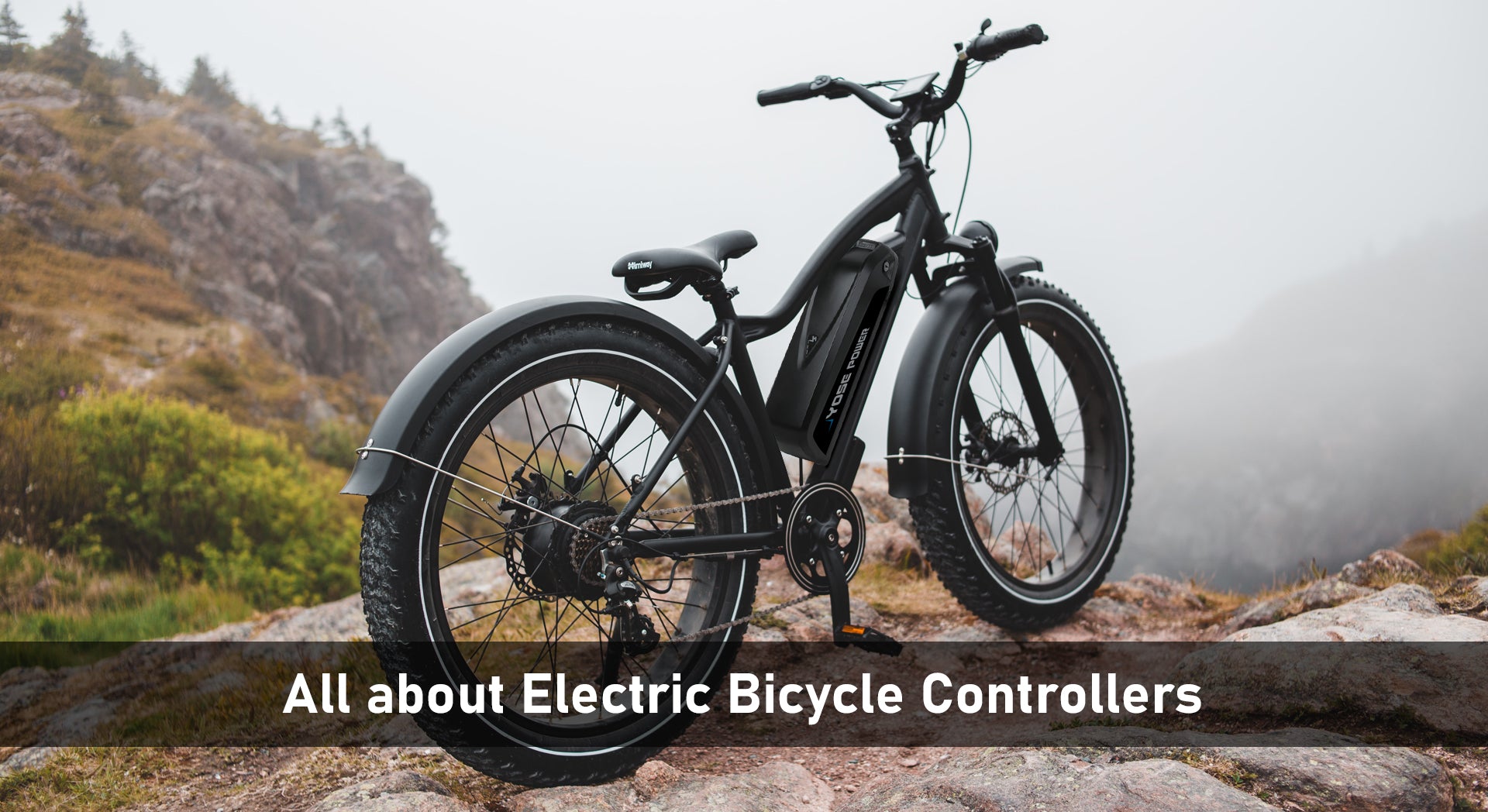Electric bicycles, also known as e-bikes, have gained significant popularity in recent years as a sustainable and efficient mode of transportation. The integration of advanced technologies has greatly enhanced the performance and functionality of these eco-friendly vehicles. At the heart of an electric bicycle lies its controller, a crucial component that governs its operation and provides a seamless riding experience. In this article, we will delve into the inner workings of an electric bicycle controller, exploring its functions, operation modes, safety features, maintenance tips, and future developments.
Electric bicycles combine the convenience of traditional bicycles with the power and efficiency of electric motors. The controller plays a vital role in ensuring a smooth and controlled ride. It acts as the central nervous system, receiving signals from various inputs and transmitting commands to the motor, thereby regulating the speed and power output.
Components of an Electric Bicycle
To understand the controller's role, let's briefly discuss the key components of an electric bicycle. The motor is responsible for generating the mechanical power required for propulsion, while the battery serves as the energy source. The controller acts as the intermediary between these components, coordinating their operation to deliver an optimal riding experience.
Understanding the Electric Bicycle Controller
The electric bicycle controller serves several essential functions. Firstly, it interprets user inputs, such as throttle commands or pedal-assist signals, and translates them into appropriate instructions for the motor. Secondly, it regulates the power output based on the desired speed or assistance level selected by the rider. Additionally, the controller monitors various parameters, ensuring the system operates within safe limits and providing vital feedback to the user.
There are different types of controllers available, ranging from simple on/off switches to more advanced models with programmable features. The choice of controller depends on the specific requirements of the electric bicycle and the desired functionality.
How Does the Controller Work?
The controller operates through a series of signal processing and communication steps. When the rider inputs a command, such as twisting the throttle or pedaling, the controller detects these signals and processes them accordingly. It then communicates with the motor, instructing it to provide the desired level of assistance or power.
To regulate power output and motor control, the controller utilizes various techniques. It adjusts the current flowing from the battery to the motor, thereby controlling the speed and acceleration. The controller also employs sensing mechanisms to monitor the rotational speed, temperature, and other parameters, enabling it to make real-time adjustments for optimal performance.
Controller Operation Modes
The electric bicycle controller offers different operation modes to cater to various riding preferences and conditions.
- Pedal-assist mode
In pedal-assist mode, the controller detects the rider's pedaling motion and provides proportional assistance based on the selected assistance level. The controller measures the speed and force applied to the pedals, instantly adjusting the power output to match the rider's input. This mode offers a more natural and intuitive riding experience, enhancing efficiency and extending the battery range.
- Throttle mode
Throttle mode allows the rider to control the speed and power output solely through a hand-operated throttle. By twisting or pressing the throttle, the rider can accelerate or decelerate the electric bicycle without the need for pedaling. This mode is particularly useful in situations where the rider requires instant power, such as during hill climbs or when starting from a stationary position.
- Combination mode
Some electric bicycle controllers offer a combination mode that allows riders to switch seamlessly between pedal-assist and throttle modes. This versatility caters to different riding scenarios and individual preferences, providing the flexibility to switch between pedaling and relying on the motor for propulsion.
Safety Features and Considerations
Safety is a paramount concern in electric bicycle design, and the controller plays a crucial role in ensuring rider safety. Modern controllers incorporate various safety features and considerations.
- Overcurrent protection
To prevent damage to the motor and controller, overcurrent protection is implemented. The controller monitors the current flow and intervenes if it exceeds a safe threshold, reducing the risk of overheating or component failure. This feature enhances the longevity and reliability of the electric bicycle system.
- Temperature monitoring
Controllers often include temperature sensors that monitor the heat generated during operation. If the temperature reaches a critical level, the controller can automatically reduce the power output or initiate thermal management mechanisms, such as fan activation or motor cutoff. Temperature monitoring protects the system from overheating and safeguards against potential hazards.
- Brake cutoff and regenerative braking
To enhance safety and energy efficiency, some controllers are equipped with brake cutoff functionality. When the rider applies the brakes, the controller interrupts the power delivery to the motor, ensuring an immediate response and facilitating effective braking. Additionally, advanced controllers may incorporate regenerative braking, which converts the kinetic energy generated during braking into electrical energy, subsequently recharging the battery and increasing overall efficiency.
Factors Affecting Controller Performance
Several factors can influence the performance of an electric bicycle controller, including:
- Battery voltage and current
The voltage and current supplied by the battery directly impact the controller's power output. Higher voltages generally result in greater speed and acceleration capabilities. Similarly, batteries with higher current ratings can deliver more power to the motor, enhancing overall performance. It is essential to select a controller compatible with the battery specifications to ensure optimal efficiency.
- Motor characteristics and power output
Different electric bicycle motors have varying power outputs and operating characteristics. The controller must be matched to the motor specifications to ensure efficient power delivery and smooth operation. Controllers designed for specific motor types can maximize performance and extend the lifespan of both the motor and the controller.
- User settings and preferences
Electric bicycle controllers often offer programmable settings that allow riders to customize parameters such as assistance levels, maximum speed limits, and acceleration profiles. These settings enable riders to tailor the electric bicycle's behavior to their specific preferences, optimizing the riding experience and meeting individual requirements.
Maintenance and Troubleshooting Tips
Proper maintenance and periodic troubleshooting can help ensure the optimal performance and longevity of the electric bicycle controller. Consider the following tips:
- Regular inspections and cleaning
Inspect the controller regularly for any signs of damage, loose connections, or water intrusion. Clean the controller using a soft, dry cloth, and ensure it is free from debris or contaminants that may affect its operation.
- Firmware updates and software calibration
Manufacturers often release firmware updates for electric bicycle controllers to improve functionality, address bugs, and introduce new features. Stay informed about firmware updates and periodically update the controller's software as recommended by the manufacturer. Additionally, some controllers may offer calibration options to fine-tune the system's performance. Follow the manufacturer's instructions to calibrate the controller to ensure accurate and reliable operation.
- Common issues and troubleshooting steps
If you encounter any issues with the electric bicycle controller, here are some common problems and troubleshooting steps:
- No power or response: Check the battery charge and ensure it is properly connected. Inspect the controller connections for any loose or damaged wires. If the issue persists, consult a qualified technician for further diagnosis.
- Inconsistent power output: Verify the throttle or pedal-assist sensor for any obstructions or damage. Ensure the sensors are correctly positioned and calibrated. If the problem persists, the controller may require adjustment or replacement.
- Overheating: If the controller becomes excessively hot during operation, check for any blockages restricting airflow around the controller. Ensure the motor and battery are operating within their specified parameters. If the overheating issue persists, consult a professional for inspection and possible solutions.
- Error codes or fault indicators: Many controllers have built-in error code systems or fault indicators to diagnose problems. Refer to the controller's user manual or contact the manufacturer's customer support for guidance on troubleshooting specific error codes.
Remember, if you are not confident in your troubleshooting skills, it is always recommended to seek assistance from a qualified electric bicycle technician or the manufacturer's support team.
Future Developments in Electric Bicycle Controllers
As electric bicycle technology continues to advance, we can expect further developments in controller design and functionality. Some potential future developments include:
- Advanced control algorithms
Advancements in control algorithms can optimize power delivery, improve efficiency, and enhance the overall riding experience. Intelligent algorithms may adapt to various terrains, rider inputs, and environmental conditions to provide optimized assistance levels and smoother motor control.
- Integration with smart technologies
The integration of electric bicycle controllers with smart technologies opens up new possibilities. Features such as GPS navigation, smartphone connectivity, and wireless communication can enhance ride tracking, provide real-time data feedback, and enable seamless integration with smart devices and applications.
- Improved efficiency and performance
Future electric bicycle controllers may incorporate advanced power management techniques, regenerative braking systems, and energy storage solutions to maximize efficiency and extend battery range. These developments aim to optimize energy utilization and provide longer and more sustainable rides.
Conclusion
The controller of an electric bicycle is a critical component that governs its operation, providing control, safety, and a seamless riding experience. Understanding how the controller works, its various operation modes, safety features, and maintenance requirements is essential for electric bicycle enthusiasts and riders. By staying informed about the latest advancements and following proper maintenance practices, riders can enjoy the benefits of electric bicycles while ensuring optimal performance and longevity of the controller system.
Learn more about e-bikes at NEWS.
Use the discount code YOSELILY to get 10€ off your e-bike purchase.


Condividere:
Tips for Cycling in Summer
How Does the Motor of an Electric Bicycle Work?